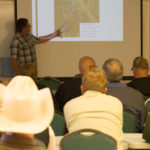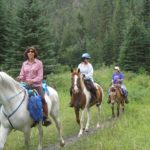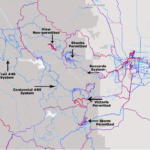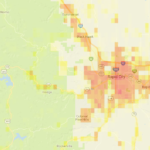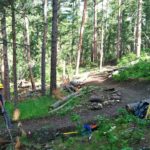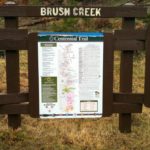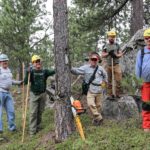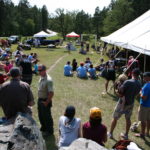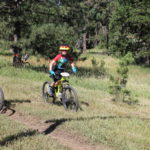The recent dispute over Forest Service Special Use Permits for long-standing cycling and running events is a hot topic [2017-RCJ-1]. The history of these Rapid City area trails goes back more than 20 years. The events that have taken place over this long span can make it difficult, as a member of the public, to be adequately informed. If these trails are lost to nature as the Forest Service intends, it could set a precedent for the next 20 years.
The Black Hills is unlike any other Forest and requires unique management. The area has just the right amount of wind, rain, and sun — Ponderosa Pine grows like weeds. Commercial timber harvests follow wherever pine grows thick. Without a proactive timber strategy walls of pine would stifle all forms of recreation. Recreational users welcome judicious logging, it keeps our Forest healthy. At the same time, there are more opportunities to adventure into the Forest here than almost any place one can imagine. Many towns are landlocked within the Black Hills National Forest. Thousands of private in-holdings sprinkle the 1.2 million acres. Residents traverse their Forest every day for much of their regular travel. The Black Hills is a place where people can, and do, hike or ride through their Forest from town to town. For those in search of adventure and a European back-country experience, the Black Hills area has been an uncharted, unmapped destination for decades.
You can’t even begin to imagine the red tape…
Understanding the history begins with understanding the development of the current Black Hills National Forest Land Management Plan. This plan is the template for Forest land management in the Black Hills and was created through public involvement including many of the same individuals still involved with trail advocacy today. This involvement resulted in a clearly stated goal for 204 miles of new non-motorized recreational trails per decade — codified in the 1997 Forest Plan.
Our elected federal representatives have painted a very clear picture through the years. The Multiple-Use Sustained-Yield Act of 1960 [1960-MUSYA], the National Trails System Act of 1968 [1968-NTSA], and the National Forest System Trails Stewardship Act of 2016, among others, tell the story. Shared use of our Forest resources is a must, but our Forests are there for our enjoyment and recreation. National Forest lands should be managed with recreation and trails in mind — especially near urban areas. The 1997 Forest plan reflected the sentiment of these federal laws.
The ball rolled slowly. Motorized recreation became a problem, and just a few short years after the 1997 plan went into effect the hikers, bikers, and horseback riders would have to patiently wait their turn through another planning process. The Black Hills National Forest was mandated as a result of litigation to create a Motorized Travel Management Plan due to non-compliance with Executive Order 11644. Finally, in 2010, the Forest Plan was amended with motorized goals, mirroring the existing non-motorized goals. The parties involved in this lawsuit demonstrated it was possible to hold the Forest Service accountable, through litigation. A 700-mile motorized trail system was established and today is nearing completion.
As the Motorized Travel Management process began winding down the non-motorized recreation community rallied, non-motorized trail users had waited long enough. Some of the Forest Service staff of the time agreed. Through the intervening years, the Forest had been effectively buying the compliance of the community with a series of Special Use Permits. Some of these stop-gap permits covered dozens of miles of trail at the urban interface of Rapid City — some of the most well-used trails in the Black Hills [2015-STRVHT]. More than that, the permits gave tacit approval of trails where they were most needed, adjacent to the major population center [POPEX]. It wasn’t a perfect solution, but in the face of budget and staffing challenges the Black Hills National Forest invested heavily in National Environmental Policy Act (NEPA) studies for short-term trail use, rather than for full-blown permanent trail systems.
In 2007, construction finally began on a single, small, stacked-loop trail system at Buzzards Roost near Rapid City. It wasn’t the ideal project, nor would it be the ideal trail system. The volunteer group Black Hills Mountain Bike Association (BHMBA), acting as representatives of the entire local hiking, trail running, and mountain biking community took on the construction and maintenance of the Buzzards Roost project, knowing it was helping the Forest Service meet their 204-mile-per-decade goal. It was, after all, expected to be the first of many new trails if the Black Hills National Forest was to meet the goals contained within its Forest Plan. Construction of the trails at Buzzards Roost concluded in 2011, and BHMBA has maintained this small 10-mile trail system for the Forest since.
The successes were still slow to come, but progress was tangible. Also in 2011, the Forest issued a volunteer agreement authorizing BHMBA to permanently maintain the dozens of miles of trails formerly covered under the stop-gap special use permits. This agreement included trails at Storm, Victoria, and Shanks Quarry. The text of this agreement made clear: it was another incremental step in the long road to these trails becoming official [2011-MOU]. In 2012, the Forest Service sought additional taxpayer-backed funding to assist in studying trail use as part of an ongoing effort to classify these trails and add them to the Forest Trail System [2012-RTP]. In the winter of 2013/2014, in the wake of winter storm Atlas, volunteers from many groups were given S-212 training by the Forest Service. This allowed these groups to help remove the immense quantity of fallen trees caused by this winter storm from the trail corridors.
The most recent chapter of this generation-long saga…
In 2014, under a new Mystic District Ranger, the rug was pulled. The ability to maintain these permitted trails went away. Volunteers were not allowed to use their S-212 Chainsaw training to maintain any trails, even system trails. In 2016, long-term Forest partners like the BHMBA were threatened with prosecution if they continued to maintain the trails they had been promised [2016-ESPLTR]. Now, in 2017, the Forest has decided to throw away the huge investments they have made in NEPA analysis and the community has made in marketing, maintenance, and long-standing efforts to move these trails from permitted status to system status. The Mystic District ranger has, at the last minute, denied a number of long-term permits that use these trails ostensibly due to a timber harvest. Perhaps the most well known of these events, the Black Hills Back 40 Mountain Bike Race, has raised more than $75,000 for local charities over the last 5 years and had anticipated $30,000 for 2017. This money was intended for the Cornerstone Rescue Mission, to benefit area homeless.
Officially, the Forest Service claims these permits are not being denied, they are working with event promoters to relocate the events. In truth, the net effect of this Mystic District action is forcing promoters to relocate their events to remedial venues and sub-standard trails. If event promoters hope to hold their event at all, they are being forced to comply. Officially, the Mystic District is citing safety due to on-going logging operations as the reason these events must relocate. In truth, timber harvests are the de-facto standard use of the Black Hills National Forest. All trail events, on a long enough timeline, must pass through an active timber sale. Safety is a non-issue, communication between logging contractor and event promoter has ensured participant safety for many years.
While the Mystic District looks backward, the Northern Hills District staff have arranged for the Dakota Five-O to operate through an active timber sale on permitted non-system trails this year. The Northern Hills District is also actively collaborating with Black Hills Trails and the City of Sturgis on a small new trail system accessing Deadman Mountain and the Sturgis City Dams.
Today’s reality and looking forward…
The reality: Adults who enjoyed these trails in their youth now take their own kids to enjoy them — despite threats of prosecution. To be fair to the entire generation that has grown up waiting their turn, the Black Hills National Forest must move forward swiftly with their plan of studying these trails for inclusion to the Forest Service system. A plan was made in 1997, based on a significant amount of public input. In 20 years the Black Hills National Forest has yet to approach even 10% of their 204-mile stated goal [2006-BHNF-EVAL]. The time to move forward is now. Well trained volunteer partners are ready and waiting to work with the BHNF to reach the goals of their Forest Plan.
It is the intent of the Mystic District Ranger to allow these permitted trail systems to be obliterated by logging operations. Despite momentum and mandate, the Mystic District fully intends to reverse more than twenty years of painstakingly slow progress. Volunteer groups, including Black Hills Trails, are continuing to work with the Black Hills National Forest. Collectively we have contributed 5000+ documented on-the-ground tool-swinging hours to Forest maintenance this decade. A generation of partnership and pursuing trails through official channels in good-faith and through fair dealings has bought the non-motorized recreation community nothing, how are they to hold the Forest Service accountable? Litigation should not be the answer.
Looking forward: If these events are not allowed to continue this year, logging operations will obliterate the trails, and they may return to nature. This trail resource and the opportunities they provide to engage in healthy, responsible recreation right at the urban interface may be gone forever. These future system trails may never be.
Please contact your federal representatives, let them know the seriousness of this issue and the need for trails:
Kristi Noem: http://noem.house.gov/index.cfm/email-kristi
John Thune: https://www.thune.senate.gov/public/index.cfm/contact
Mike Rounds: https://www.rounds.senate.gov/contact/email-mike
Referenced Documents:
[2017-RCJ-1] – Rapid City Journal article about permit denials
[2016-ESPLTR] – 2016 Letter from Mystic District Ranger Ruth Esperance to trail community
[1960-MUSYA] – 1960 Multiple-Use Sustained-Yield Act
[1968-NTSA] – 1968 National Trail System Act
[2012-RTP] – 2012 Recreational Trails Program Grant Request from Black Hills National Forest


